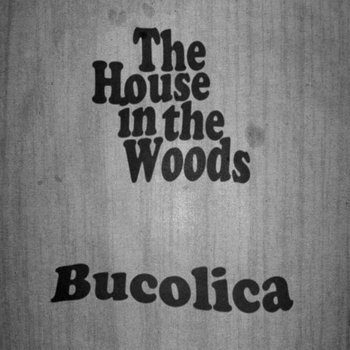
The House In The Woods is a new project for Pye Corner Audio Head Technician Martin Jenkins. Where it differs from his work under other names for other labels (particularly Ghost Box) is in the level of obscurity. Gone are his signature clear retrosynth lines and vaguely ominous washes – in its place is pure confusion and cul-de-sacs where one expected an exit. Bucolica is more in line with Nurse With Wound’s less Dada moments, or with the concrete mist Leyland Kirby constructs as The Caretaker. There’s certainly the questing melancholia of the BBC Radiophonic Workshop here – except we’re listening to the tapes long after everyone on earth is dead.
This is not background music, however lulled you may feel. It’s mostly unclear what’s going on – the listener must find what meaning they can in what they hear, and what’s presented isn’t easily dismissed or left aside while one does the hoovering. The album demands to be described as narrative, not musical structure: the pieces pinned to a board not by their scales and keys but by the imagery they encourage.
If you’re looking for shorthand, you could probably throw around images of misty forests, of lapping shores, of curtains a-twitch in a strange village. Even compared with Jenkins’ other enigmatically evocative albums, Bucolica has some meaty hooks. There’s always something coming. We can’t see it. We don’t know where it is. But that tingling of the hair on your forearms tells you it’s not going to be good.
Album opener ‘Severton Pathway’ establishes mood. Crackling sounds surmount the sort of synth found in the bubbling intro to Godiego’s theme music for Monkey. The synth shuffles until it’s displaced by gusting winds and a more sustained, monolithic drone. Through headphones there’s the feeling of transportation – the listener is taken. A voice sputters from a Tannoy, incomprehensible. But is it another language, or do my ears no longer work? Winds rise, blend with the synths until they merge into the sound of loss.
Throughout, there’s a feeling of weather. Even though we know (or think) most of this album is made with an electronic toolkit, one is reminded of field recording. The clever ‘Half Glimpsed’ conveys the “ping-pong” moments in Gavin Bryars’ Point Records release of The Sinking Of The Titanic – sound fleeing a deep chamber. ‘Bucolica’ – the most Ghost Box-style track on the album – contains some surface-noise-cum-trains-whistling-cum-windy-regret sounds which become more prevalent. The elements distort the tracks as they’re laid down; the moments of joyous melody found inside the synths on ‘Bucolica’ are warped, as if pulled by an unseen force, a distortion field which only exists in the land described by the album.
Elsewhere, ‘Mountains Of The Sea’ conveys a hissing, grimacing electricity. It comes as water to the shore – advancing to where you are, almost, then retreating. Then a little closer, a little further. Do you want to be wet? Do you want to allow this noise – this babbling of strange, half-heard voices – to touch you? It’s properly lurking fear with a generator attached, only leavened by the sound of a sunrise, as a majestic orb floats above the waves in dizzying glory until it fades – as often seems the default.
Across the album there’s a hat-tip to Akira Yamaoka’s work on the Silent Hill gaming franchise. Where most of those soundtracks – for the non-gamers – relied on percussive horror, there were moments of meditative, unsettling beauty built on morphine-fuzz synth patches, which was comforting yet concealing. ‘Sunlight On Rusting Hulk’ is one example. There’s a beat buried deep in the track and the ear spends time trying to find it; an implied wub wub wub of rotors buried in the shifting winter of soft static. The keys on the track span two positions, yet it nails a note of retrospective malaise a la Boards of Canada. The piece becomes more wistful – and involved -, but the same woozy reminiscence and concealment remains.
The principle of Bucolica appears to be obfuscation; snatches to gain orientation. ‘Untitled Blackniss’ is the sound of waiting, as something large and mechanised – accompanied by the pan-pipes of the damned – comes. ‘Dark Lanterns’ offers a feast of winds and pregnant statis, while ‘Favershell’ is a soundtrack to a procession of the devotees of Dagon, heard from a few streets over. You can hear something either excellent or fucked is occurring just over there – but you’re uncertain you need to see it. It’s not going to make you feel any better, is it?
This doomed feeling reaches the endpoint in ‘The Rain Washed Away’; strings under wind, at once stately and rotten. The sound builds in loops, until – halfway through the track – comes a deeper sound, a funereal plod, a dead march in the coldest winter. More sounds – a guitar? – and the feeling of approaching menace. And then we’re cut dead – everything ebbs, decreasing and warping, the sound of defeat, wow and flutter. All is cold mystery. I don’t have a clue what’s going on, or where I am. Or when I am.
If you’re interested in hauntology/early synth/field recordings/soundtrack-to-a 1970s-children’s-show-erased-from-archives spookiness, The House In The Woods is perfect. Is isn’t as strident as, say, Goblin or Umberto, but Jenkins aims for an identical nerve of uncertainty and fear. Nothing in here feels good, despite the glow of some tracks. The album’s a soundtrack in the true sense – you will see the house in the woods, people without mouths, weathered photo albums and tendrils of fog insinuated through crack’d windows.
This is not background music: leave on the lights. And for god’s sake, don’t go in the shed.
LUKE MARTIN



